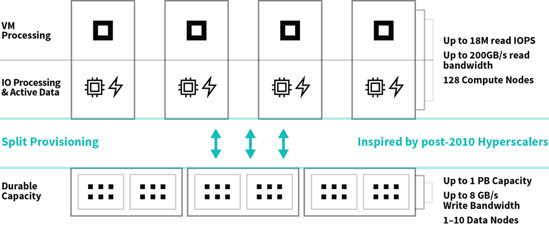Datrium DVX 3.0 With Split Provisioning For Simple Private Cloud Consolidation at Rackscale
Independent scaling of capacity and IO processing in server-powered converged system, scaling to 1.7PB and 200GB/s bandwidth
This is a Press Release edited by StorageNewsletter.com on August 25, 2017 at 2:48 pmDatrium, Inc. announced DVX 3.0 with Split Provisioning, a new and different method of scaling converged infrastructure for private clouds.
DVX version 3.0 split provisioning architecture
DVX with Split Provisioning is a server-powered converged infrastructure system to separate scaling of host storage speed and persistent capacity to simply and incrementally match resources to evolving tenant requirements. The software provides scaling from 1-128 compute nodes, or up to 200GB/s IO bandwidth, and from 1-10 data nodes, or up to 1.7PB of capacity, in a single composable pool.
The company will demonstrate its DVX platform with Split Provisioning at the VMworld conference in Las Vegas, NV.
Unlike open converged infrastructure, hyperconverged infrastructure (HCI) approaches maintain persistent data on every server and are limited to two or three simultaneous server failures before users experience a data outage. As a result, HCI users tend toward smaller clusters, across which servers and workloads should be homogeneous.
According to Gartner, Inc., “In today’s world, most hyperconverged deployments are in the range of eight to 16 nodes,” (1) so rackscale deployments need multiple clusters, each of which needs configuration and administration. Gartner has concluded that “many mainstream enterprise IT directors do not yet trust SDS in HCIS solutions to deliver multi-petabyte capacity at scale for tier 1 mixed workloads that require low latency.“ (2)
10X greater consolidation
With Split Provisioning, DVX scales compute with both primary and secondary storage resources in a new way. compute nodes run all workloads in local commodity flash for high performance and low latency. Each compute node writes persistent data to network-attached, capacity-optimized data nodes, which are similar to purpose-built backup appliances optimized for cost efficiency and sequential IO. Because compute nodes are stateless, any number of them can go down for service without affecting data availability.
Until now, DVX supported a single data node. With DVX 3.0 and Split Provisioning, a single DVX can pool multiple data nodes, each of which adds capacity and write bandwidth. While the minimum DVX configuration is one compute node and one data node, Split Provisioning allows scalability up to 128 compute nodes and 10 data nodes in a single system. Adding a data node to a pool is a one-command operation, after which the system automatically and non-disruptively re-balances capacity.
System-wide performance and capacity increases up to:
-
200GB/s read bandwidth and 18 million IO/s (3), an order of magnitude higher than market-leading all flash arrays (4), for read intensive applications like SQL Server or VDI boot storms;
-
8GB/s write throughput, for write-intensive applications such as ingest operations for big data analytics or data warehousing;
-
1.7PB of effective capacity.
“At Parametric, we provide engineered portfolio solutions to institutional investors and private clients built on quantitative, rules-based analysis. Our largest private cloud environment has grown 200-300% over the last year, and have received requests for 80 to 100TB for a single project,” said Ben Garforth, manager, systems engineering, Parametric Portfolio LLC. “With Datrium and Split Provisioning, I can now handle our massive data growth cost effectively and non-disruptively within a single resource pool. And better still, I don’t need to manage a thing-I check in on the Datrium solution once a month and that’s about it.“
“Datrium’s premise has always been that their ‘open convergence’ method delivers better overall scalability, along with independent scalability of performance and capacity, compared to hyperconverged architectures – in essence, private clouds with virtually limitless performance and scale with the ease of public clouds,” said Arun Taneja, founder and consulting analyst, Taneja Group. “Split Provisioning delivers further proof point for their claim. With the pace of innovation coming from Datrium, I can’t wait to see what comes next.“
Converging compute with primary and secondary storage
DVX converges compute with both primary and secondary storage, and Split Provisioning takes this to a new scale. Compute nodes write data to low cost, disk-based data nodes with always-on global deduplication, inline compression, erasure coding and Blanket Encryption. Data Cloud, company’s built-in cloud data management software, can manage up to 1.2 million snapshots per DVX, replicable to other DVX’s or to Amazon Web Services.
For additional data protection, DVX 3.0 offers application-consistent snapshots for Windows-based applications such as MS SQL Server. The firm’s Volume Shadow Service Provider leverages instantaneous and scalable DVX Snapshots, eliminating VM stuns and related sluggish application performance for large data sets.
“As specialty appliances decline, the future of private clouds will look like DVX,” said Brian Biles, CEO and co-founder, Datrium. “Split Provisioning enables an order of magnitude more application bandwidth than most all-flash arrays, much simpler rackscale consolidation than HCI, and better secondary storage than either. This is tomorrow calling.“
Resources:
DVX Specification Sheet
DVX Data Sheet
Split Provisioning Technical Whitepaper
Blog: And The Third Shoe Drops
(1) Gartner: Key Differences Between Nutanix, VxRail and SimpliVity HCIS Appliances | 26 April 2017
(2) Gartner: Beware the ‘Myth-Conceptions’ Surrounding Hyperconverged Integrated Systems | 18 February 2016 refreshed 02 June 2017
(3) Performance based on Datrium Lab Testing. Bandwidth measured with 64K IO size 100% read. IO/s measured with 4K IO size, 100% read | July 2017
(4) From XtremIO specifications sheet














 Subscribe to our free daily newsletter
Subscribe to our free daily newsletter

